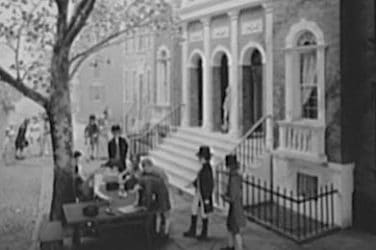Every journey begins with a single step.
Back in 2013 market maker GETCO was looking to drive it business forward in a stagnant commission rate and highly competitive market making environment. In exploring its limited options, GETCO opted to purchase Knight. Knight had a profitable business model as a market maker and a very profitable wholesaling and retail facing business. Seemed a like a good match – but was it?
Spencer Mindlin, capital markets analyst at Aite Group remembered the time and recounted to Traders Magazine just what was going on and what was at stake.

Spencer Mindlin, Aite
“GETCO picked up Knight in order to diversify its business, which at the time was almost exclusively prop trading, with Knight’s customer-facing businesses,” Mindlin began. “GETCO was struggling because of increased competition and the Knight acquisition was very attractive. But the integration was challenging, to say the least.”
Mindlin recalled that the merger required both firms having to navigate through difficult clashes of corporate cultures, key personnel exits, and painful organizational restructuring, technology integration, and perception management with clients abound with concerns about interacting directly with toxic HFT liquidity.
“It’s hard to say that it worked out as planned, as the merged company failed to meet performance expectations. But KCG did eventually remain a market-making marker leader, with only Citadel as the larger firm in the space.”
Looking at the current market, Virtu Financial likely found itself in a similar spot as GETCO and picked up KCG in 2017, four years after GETCO acquired Knight. Through the looking glass, Virtu appears to be executing from the same playbook as GETCO, and experiencing the same challenges executing the prior merger.
“Still, market making has effectively become a scale and speed business. The Virtu acquisition of KCG enabled Virtu to enter a complementary business and acquire the second-place competitor, only behind Citadel, in a consolidating market,” Mindlin said. “Both deals had cost synergies beneficial to shareholders.”
And for market maker Virtu, the journey to increased profitability and efficiency, buying KCG and getting its highly-profitable Wholesale and Retail order flow businesses seems a perfect match. But has it been?
So far, things seem to be good for Virtu. It recently reported its fourth quarter earnings and in looking at the details the firm’s market making unit’s adjusted net trading income stood at $204 million, up 50% from the previous quarter.
On its fourth quarter earnings call, Chief Executive Officer Doug Cifu described the union of the firm and KCG as “the ultimate market making firm” after it outperformed in the last three months of 2017.
“Our conviction that the two firms market making styles and cultures are remarkably complementary has been proven correct and we believe that there are ample opportunities in front of us to grow revenue further,” Cifu said.
“We continue to enable additional opportunities for internalisation across both firms, thereby being more efficient and intelligent about our hedging activities,” Cifu told investors. “We are only beginning to achieve trading efficiencies and harmonise the strengths of both legacy firms and we believe there’s a lot of growth ahead for the combined firms as we continue to implement more combined Virtu and KCG style strategies.”
Cifu continued that separately both KCG and Virtu had market making models with problems but from very different perspectives.
Virtu lacked the customer base and had to deal with market making activities in public markets and in dark pools. Whereas at KCG, the market making business struggled continuously following significant drops in quarterly revenues before it finally decided to shut down the business for options and corporate bonds.
The following article first appeared in the February 2013 edition of Traders Magazine
Becoming a Superpower
GETCO’s Looks to Knight’s Wholesale and Retail Businesses as Keys to Growth
By Gregory Bresiger
GETCO, which began as a prop shop, intends to use Knight Capital Group’s wholesaling connections along with large retail order flow to become a trading superpower. That, it hopes, will make it a trading power that will attract new institutional clients.
This is what trading executives told Traders Magazine about the electronic market maker’s pending $1.4 billion deal to purchase liquidity giant Knight. Founded in 1995 and headquartered in Jersey City, Knight is also one of the largest market makers on the New York Stock Exchange-as is GETCO.
Those relationships will help GETCO grow its business at a difficult time for equities, according to says Howard Tai, a senior analyst with Aite Group’s capital markets practice.
Indeed, average daily volume in 2012 fell 17.6% to a level that is 33.9% lower than the peak of 9.8 billion shares a day in 2009, according to statistics compiled by Rosenblatt Securities. Knight makes markets and trades in some 19,000 U.S. equities, handling 3.0 billion shares a day, worth in excess of $20 billion.
This large volume of trading should give GETCO great leverage in controlling its costs, several market participants said. But, more important will be connections with mutual funds and other institutional customers that come with owning Knight.
“The purchase will extend GETCO’s wholesale distribution network,” Tai said, pulling in large waves of orders from discount brokerages such as Ameritrade and ETrade, which serve retail customers.
GETCO must follow this acquisition path, several executives said, because the high-speed trading firm, originally established as the Global Electronic Trading Company, not only faces limits from lower volume, but in market making itself.
“Clearly, some of the electronic trading firms like GETCO are running out of new markets to go into with their current business model,” according to Matthew Andresen, co-CEO of Headlands Technologies, a global quantitative proprietary trading firm in Chicago.
Firms who trade their own capital, even as high-speed market makers, reach a dead end when institutional investors pull back on buying and selling stocks.
“You’re really relying on this institutional volume in the marketplace and if that volume has subsided, so too has electronic market making,” said one brokerage executive. “Then you will have to go out and fight for a piece of that action. And it is very difficult to get a significant piece of that volume, if you don’t have it sent to you directly.”
Thus, GETCO to continue growing has to find a direct route to retail flow, said the broker, who declined to be quoted by name.
A Knight purchase “gets them the best distribution network in the industry,” says Chris Nagy, president and founder of Omaha-based KOR Trading, a strategic advisory firm. Small broker-dealers, large online brokerages and banks all are “physically connected” to Knight, he says, and can send it orders, directly.
Knight’s level of wholesaler connectivity is “unmatched” in the industry, Nagy says. This network, which serves hundreds of retail brokers including behemoths such as Fidelity Investments and TD Ameritrade Holding Corp., he adds, was built up over about a decade and probably would be impossible to re-create, given the dramatic cost changes in the trading industry, he adds.
Nagy also says GETCO has the best technology for high speed trading and market making.
Why?
GETCO has automated programs, known as trading robots, that are able to be turned on and off during the trading day, as needed, Nagy says. No one else has this particular feature in their high-speed trading, besides TradeBot, he said.
GETCO last fall also formed a technology alliance with brokerage Mismi Inc. That alliance puts GETCO trading algorithms onto the handheld devices used by Big Board floor brokers. GETCO becomes one of a small number or electronic tool providers on the NYSE.
The firm started electronic trading in equity futures in 2000, equities in 2001, fixed-income securities in 2003, commodities in 2004, foreign exchange in 2005 and equity options in 2007. It became a liquidity provider in four asset classes in 2005. And a market maker on the New York Stock Exchange in 2010.
These moves included starting an alternative trading system, known as GETMAX in 2007. That system could leverage KnightDirect, a comprehensive execution management system which offers buy- and sell-side clients direct access, electronically, to different destinations. KnightDirect handles 203.1 million shares a day, for instance.
“So I would imagine that GETCO’s dark pool gets attached to KnightDirect in some fashion,” Nagy says.
“I see all this as part of an effort by GETCO to diversify away from pure electronic prop trading,” Andresen adds, risking its own money all the time.
That is also key for getting the institutional customers it covets. Institutions are wary of GETCO. That’s because of its roots in high-frequency trading, where the rush to grab orders by getting to the front of the line the fastest can steal orders away from slower-footed rivals. That can raise the costs of institutional traders, who are trying to move large blocks of stock undetected.
Some institutions, in fact, have criticized it as an HFT bullyboy over its 15-year history. (See “GETCO History” Sidebar). That could mean the Knight acquisition may be a way to establish relationships GETCO otherwise could not obtain.
“Knight has buyside relationships that GETCO simply doesn’t have,” said one brokerage executive who deals with both.
GETCO, citing a quiet period owing to its pending purchase of Knight Capital, declined comment.
But, in a public statement when the sale was recently announced, GETCO chief executive Daniel Coleman said the combined company would be a leader in both market-making and agency execution. And that its influence would cross “geographies, market structures and asset classes.” He predicted the merged entity would be “a magnet” for “talented traders and technologists, which is especially important in an environment of lower trading volumes and higher regulatory environment.”
Unstated in the GETCO press release, several industry executives said, is that GETCO is following the same path as Citadel Investment Group, another high-frequency trading firm as well as other firms that began as prop shops and expanded into other kinds of trading because they were reaching a dead end and feared having to battle for more order flow.
Market makers and wholesalers essentially have to pay online brokers for the privilege of trading against an order. This competition for order flow can be fierce when order flow is weak as it has over the last few years. Trying to survive in difficult times, some firms will pay for other flow. One critical element in surviving, says a former Getco official, is getting at that flow as soon as possible.
To get that order flow, GETCO is willing to deal. “When you interact with the retail flow, you want to be as far up the food chain as possible. So the reason Citadel would offer a payment to trade with TD Ameritrade and others is because that’s the type of retail flow they can make money with,” says Keith Ross, CEO of Chicago-based PDQ, operator of an alternative trading system named for Procedure Derived Quotes and that is a registered broker dealer.
GETCO also is positioning itself earlier in the trading process, to boost its bottom line, he adds.
“Typically, a retail order these days goes to an institution to be filled internally and, if not filled there, it may go to a dark book, and then possibly end up in the lit market. Essentially there’s a sequencing of the order. The sooner you get to see and respond to the order, the more profit opportunity you have. This acquisition will put them (GETCO), very early, possibly the first step, in the chain, and thus increase the likelihood of profitability on each trade,” according to Ross, a former CEO of GETCO who left then private firm in 2005.
So what could go wrong in the marriage of Knight with GETCO?
Nagy says some parts of Knight, a huge broker that dwarfs GETCO, are problematic. For instance, the bond operations, corporate and reverse mortgage operations have been problems, he says. Nagy says they have been consistent money losers and recent numbers support that view.
In the third quarter of 2012, for instance, Knight said it recorded a non-cash impairment charge of $143.0 million, representing $126.4 of goodwill related to the institutional fixed income and asset management businesses and $16.7 million of intangible assets related to the its designated market making, asset management and reverse mortgage businesses.
Indeed, the corporate division also lost $22 million in the first half of last year. Knight’s corporate subsidiary includes strategic investments primarily in financial services-related ventures, clearing and settlement activity, corporate overhead expenses and all other expenses, according to Knight’s website.
A big issue is whether GETCO can retain Knight’s considerable wholesaling relationships.
To keep those relationships, “you will see them keeping the Knight name. It will be important to retain a Knight entity as much as possible,” said one hedge fund manager. “Using Knight as entrée to the buyside will help people forget any problems they have had with GETCO.”
That reflects the friction that sometimes surfaces between institutional firms and GETCO. Some big money managers such as Fidelity Investments and Vanguard Group, at different points, have expressed concern about high-speed firms such as GETCO and Citadel. GETCO has had its trading industry battles. GETCO’s supporters say those battles are behind it. They note it started an agency brokerage some 16 months ago, GETALPHA, and today its clients are some of the biggest money managers in the business. Nevertheless, suspicions about GETCO and other HFTs persist.
“Right now the buyside is worried that they’re going to be gamed by the high frequency players,” said PDQ’s Ross.
“But it turns out the high frequency players are worried that the buyside has all the good information about where stocks are going and they’re (the HFTs) going to be taken advantage of. So given the current market structure it’s actually a mutual fear,” he says.
But that could change, said Aite’s Tai.
“Some people will never give up their prejudices against GETCO. But GETCO will try to work with a new generation of trading professionals,” according to Tai.
One last potential danger of the Knight deal is the potential for the merged company to be plagued by bureaucracy. The merged company will have close to 1,900 employees. That could impact both decision-making and costs.
“They (GETCO) have been one of the biggest HFT players in the last decade. But costs and equity volumes have declined and the costs of running the business have continued to increase,” said one hedge fund manager, who declined to be quoted by name.
“The merged company,” the manager concluded, “could be big, hard to manage and hard to rationalize. To make this deal work, you’re going to have to have a fine pencil exercise.”
Pencil work done, GETCO has made a good deal in buying Knight, though, Nagy believes.
“You will essentially have the number one liquidity provider in the marketplace coupled with the number one distribution network,” Nagy says. “This new entity is walking in the door with advantages than none of the other liquidity providers or wholesalers have.”





